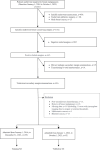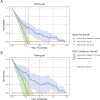An intraoperative nomogram for predicting secondary margin positivity in breast conserving surgery utilizing frozen section analysis
- PMID: 39839802
- PMCID: PMC11746899
- DOI: 10.3389/fonc.2024.1366467
An intraoperative nomogram for predicting secondary margin positivity in breast conserving surgery utilizing frozen section analysis
Abstract
Background: Breast conserving surgery (BCS) is a standard treatment for breast cancer. Intraoperative frozen section analysis (FSA) is widely used for margin assessment in BCS. In addition, FSA-assisted excisional biopsy is still commonly practiced in many developing countries. The aim of this study is to develop a predictive model applicable to BCS with FSA-assisted excisional biopsy and margin assessment, with a focus on predicting the risk of secondary margin positivity in re-excision procedures following positive initial margins. This may reduce surgical complications and healthcare costs associated with multiple re-excisions and FSAs for recurrent positive margins.
Methods: Patients were selected, divided into training and testing sets, and their data were collected. The Least Absolute Shrinkage and Selection Operator (LASSO) was used to identify significant variables from the training set for model building. Model performance was evaluated using Receiver Operating Characteristic (ROC) curves, calibration curves, and Decision Curve Analyses (DCAs). An optimal threshold identified by the Youden index was validated using sensitivity, specificity, positive predictive value (PPV), and negative predictive value (NPV).
Results: The study included 348 patients (256 in the training set, 92 in the testing set). No significant statistical differences were found between the sets. LASSO identified six variables to construct the model and corresponding nomogram. The model showed good discrimination (mean area under the curve (AUC) values of 0.79 in the training set and 0.83 in the testing set), calibration (Hosmer-Lemeshow test results (p-values 0.214 in the training set, 0.167 in testing set)) and clinical utility. The optimal threshold was set at 97 points in the nomogram, yielding a sensitivity of 0.66 (0.54-0.77), specificity of 0.80 (0.74-0.85), PPV of 0.56 (0.47-0.64) and NPV of 0.86 (0.82-0. 90) for the training set, and a sensitivity of 0.65 (0.46-0.84), specificity of 0.88 (0.79-0.95), PPV of 0.68 (0.53-0.85) and NPV of 0.87 (0.81-0.93) for the testing set, demonstrating the model's effectiveness in both sets.
Conclusions: This study successfully developed a novel predictive model for secondary margin positivity applicable to BCS with FSA-assisted excisional biopsy and margin assessment. It demonstrates good discriminative ability, calibration, and clinical utility.
Keywords: breast conserving surgery; frozen section analysis; intraoperative decision making; margin assessment; nomogram predictive model; surgical margin positivity.
Copyright © 2025 Li, Jiang, Wu, Luo and Li.
Conflict of interest statement
The authors declare that the research was conducted in the absence of any commercial or financial relationships that could be construed as a potential conflict of interest.
Figures






References
-
- Houssami N, Macaskill P, Luke Marinovich M, Morrow M. The association of surgical margins and local recurrence in women with early-stage invasive breast cancer treated with breast-conserving therapy: A meta-analysis. Ann Surg Oncol. (2014) 21:717–30. doi: 10.1245/s10434-014-3480-5 - DOI - PMC - PubMed
LinkOut - more resources
Full Text Sources

